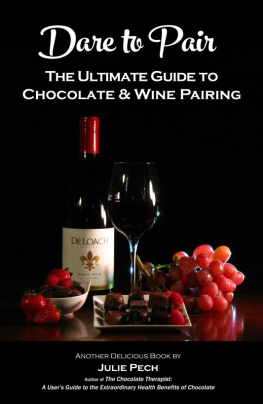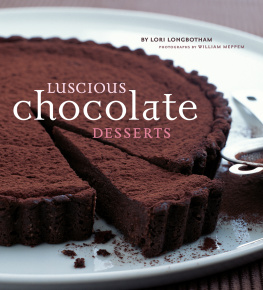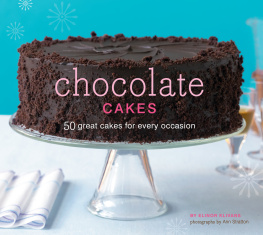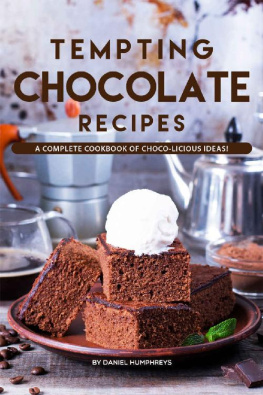
For my parents, and for Hamish.
Copyright 2014 by Eagranie Yuh.
All rights reserved. No part of this product may be reproduced in any form without written permission from the publisher.
Library of Congress Cataloging-in-Publication Data available.
ISBN 978-1-4521-1164-3 (pb)
ISBN 978-1-4521-3001-9 (epub, mobi)
Design and illustration by Erin Jang
Chronicle Books LLC
680 Second Street
San Francisco, California 94107
www.chroniclebooks.com
Introduction
I LOVE CHOCOLATE. I love its diversityhow theres delicate, nuanced chocolate that makes me sit and ponder, and how theres uncomplicated chocolate doped with nuts that satisfies my craving for crunch. I love that delicious chocolate is the result of peoples hard work, passion, and dedication to getting every detail right. I love when I share chocolate with friends and their eyes light up, and when I share it with strangers and make new friends.
There has never been a better time to love chocolate. You can find a decent chocolate selection in most grocery and specialty stores, and even shop at stores devoted entirely to fine chocolate. You can take seminars on chocolate, pair chocolate with beverages, and enjoy chocolate at every stage of a five-course feast.
You can explore chocolate in confections and truffles, or savor the inherent flavors of chocolate by itself. Did you know that chocolate can taste like dried cherries, cloves, caramelor even mushrooms, rose petals, or toasted nuts? Whats more, these notes are inherent to the chocolate itself, not derived from added flavorings.
Do you prefer bright and fruity chocolate, or dark and earthy? The only way to find out is by tasting. In this guide, youll learn how to select, shop for, and taste chocolate. And, to help you get started, Ive highlighted some of my favorite makers in sidebars.
Taste chocolate. Taste promiscuously. Taste alone; taste with friends. Taste high percentage, low percentage, single origins, blends. Taste chocolate with stuff in it. Taste chocolate that got ace reviews and ask what the big deal is. Taste chocolate youve never heard of and wonder why it took you so long to try it.
Taste chocolate. Its a tall order, but Im sure youre up for the challenge.
THE
SECRET
LIFE
OF
CHOCOLATE
IN THE 1500S, the Veracruz coast on the Gulf of Mexico was the place to be. There, Aztecs reveled all nightfeasting, dancing, and drinking chocolate laced with cinnamon, anise, pepper, and orange blossoms. Legend has it that the warrior Montezuma consumed fifty chalices of the brew before attending to his harem of wives. History has not recorded their reactions.
A civilization earlier, the Mayans popularized drinking chocolate, sometimes spiked with achiote, which would stain the drinkers lips blood-red. But the first humans to consume cacao were the Mokaya, a group of fishers and farmers who lived in what is now Mexicos Chiapas state between 1900 and 1500 B.C.
More than three thousand years after the Mokaya, Christopher Columbus encountered cacao off the coast of Honduras. In 1527, Hernando Corts took cacao beans back to Spain, but it wasnt until 1585 that Spanish traders began to ship them in earnest, kicking off the worlds love affair with chocolate.
By the 1700s, chic Europeans were flocking to cafs to sip chocolate. The French version was thick and luxurious, while Italians preferred a thinner brew scented with orange or lemon.
Then there was the Industrial Revolution. In the 1800s, Coenraad van Houten invented dutching, a process to make poor-quality cocoa powder more palatable. Similarly, Swiss inventor Daniel Peter, helped by Henri Nestl, invented milk powder, which eventually led to milk chocolate. And Rodolphe Lindt invented the conche, a machine that agitates chocolate to refine its flavor and texture.
Today, chocolate is equal parts childhood delight and grown-up indulgence.
But where does it come from?
Chocolate Grows on Trees
YES, CHOCOLATE GROWS on trees. To be precise, chocolate is made from cacao, the fruit of Theobroma cacao, a fussy tree that grows up to 20 degrees above and below the equator, in an area known as the cocoa belt. Brightly colored cacao pods jut straight off the trees trunk and main branches, looking like ridged, elongated footballs. Workers harvest each cacao pod by hand, wielding a sharp blade attached to a long stick.
Inside each pod are twenty to forty seeds, each swaddled in slimy white pulp that tastes like the love child of lychee, guava, and papaya. The seeds are piled together, fermented for two to fourteen days, and stirred regularly. During this time, bacteria and yeasts from the air convert sugars in the fruit into a soup of acids and alcoholsin the process, creating flavor precursors, the building blocks of flavor. After fermentation, the beans are dried, packaged in burlap bags, and then shipped to a chocolate maker.
Chocolate from Bean to Bar
CHOCOLATE MAKERS transform cacao beans into chocolate by roasting, winnowing, grinding, and conching.
First, roasting turns the flavor precursors developed during fermentation into full-blown flavors. Next, the beans are winnowed to remove their papery husks, crushed into cacao nibs, and ground into a paste. At this point, the name switches from cacao to cocoa. That is, the cacao nibs are ground into a paste, called cocoa mass or cocoa liquor. Cocoa mass and cocoa liquor are used interchangeablyand to add to the confusion, theres no alcohol involved.
To the cocoa mass, a chocolate maker can add sugar to make dark chocolate, or sugar and milk powder to make milk chocolate. (White chocolate isnt actually chocolate; its a mixture of cocoa butter, milk powder, and sugar. Find out more on .) Some chocolate makers may add lecithinan emulsifier that improves chocolates fluidityand vanilla.
Next, chocolate is refined in a conche for two to forty-eight hours. A conche is a machine that heats and agitates chocolate to improve texture and flavor. It takes skill to drive off undesirable flavors while retaining desirable ones. Underconched chocolate can be harsh and acidic, and overconched chocolate flat and lifeless.
After conching, chocolate is tempered. At a molecular level, chocolate can adopt up to six arrangements, but only two of them are stable. Tempering is the process of coercing chocolate into a stable arrangement, providing its characteristic qualities of shine, snap, and meltability.
Once tempered, the chocolate is packaged for shipping. Stored in a cool, dry place, it can last a year or more.
Mass-Market and Fine Chocolate
MASS-MARKET CHOCOLATE IS UBIQUITOUS its the stuff at corner stores and gas stationsbut most of it contains more sugar than chocolate. Fine chocolate used to be harder to find but is increasingly available at grocery stores and specialty shops. Fine chocolate costs more than mass-market, but for good reason. It all starts with the cacao beans.
Mass-market chocolate is made with cacao beans that have little or no inherent flavorwhat the chocolate industry calls bulk beans. Ninety percent of the worlds cacao, coming from the Ivory Coast, Ghana, and Indonesia, falls into this category. Mass-market chocolate is made in bulk, so mass-market companies use a uniformly dark roast to neutralize the variations among beans and obliterate any outlying flavors. The result is a consistently bland product, year after year. (Notably, dark-roasting brings out the bitterness in chocolate, which is why so many people think dark chocolate is bitter.)
Next page








